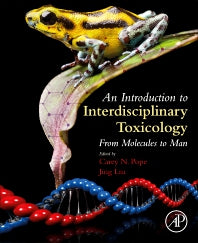Freshly Printed - allow 10 days lead
Couldn't load pickup availability
An Introduction to Interdisciplinary Toxicology
From Molecules to Man
Integrates various aspects of toxicology, from "simple" molecular systems, to complex human communities, including expertise from a range of interacting disciplines
Carey N. Pope (Edited by), Jing Liu (Edited by)
9780128136027, Elsevier Science
Paperback, published 21 February 2020
644 pages
23.4 x 19 x 3.9 cm, 1.47 kg
An Introduction to Interdisciplinary Toxicology: From Molecules to Man integrates the various aspects of toxicology, from “simple? molecular systems, to complex human communities, with expertise from a spectrum of interacting disciplines. Chapters are written by specialists within a given subject, such as a chemical engineer, nutritional scientist, or a microbiologist, so subjects are clearly explained and discussed within the toxicology context. Many chapters are comparative across species so that students in ecotoxicology learn mammalian toxicology and vice versa. Specific citations, further reading, study questions, and other learning features are also included.
The book allows students to concurrently learn concepts in both biomedical and environmental toxicology fields, thus better equipping them for the many career opportunities toxicology provides. This book will also be useful to those wishing to reference how disciplines interact within the broad field of toxicology.
I. General Concepts 1. Principles 2. Sources of exposures: Point vs Nonpoint Source Contamination 3. How chemicals distribute in the physical environment 4. How chemicals distribute in cells and simple organisms 5. How chemicals distribute in complex organisms
II. Responses to chemical toxicants 6. Cellular responses to toxicants 7. Genotoxicity and epigenetics 8. Carcinogenesis 9. Disruption of cell signaling 10. Altered development and reproduction 11. Microbiome alterations and modulation of toxicity 12. Nanotoxicology
III. Organ System Effects 13. Dermal system 14. Gastrointestinal system 15. Excretory system 16. Respiratory System 17. Cardiovascular system 18. Musculoskeletal system 19. Endocrine system 20. The immune system 21. Visual system 22. Nervous system
IV. Ecosystems and Ecotoxicology 23. Organism vs population 24. Bioconcentration 25. Biomarkers
V. Toxicology in the Home 26. Opiates and other therapeutics 27. Cleaning products 28. Petroleum products
VI. Toxicology in the Community 29. Historical case studies 30. Social factors in community contamination
VII. Forensic Toxicology
VIII. Regulatory Toxicology 31. Toxicity testing 32. Tox21 33. Principles of Risk Assessment
IX. Reference materials and websites 34. Information Resources in Toxicology, 4th edition. 35. National Toxicology Program 36. National Center for Toxicological Research 37. FDA 38. EPA
Subject Areas: Medical toxicology [MMGT]


